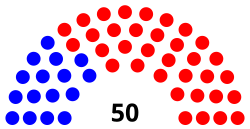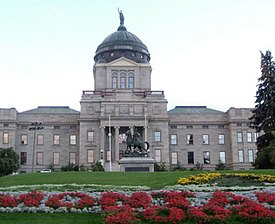
The California State Legislature is the bicameral state legislature of the U.S. state of California, consisting of the California State Assembly and the California State Senate. Both houses of the Legislature convene at the California State Capitol in Sacramento.
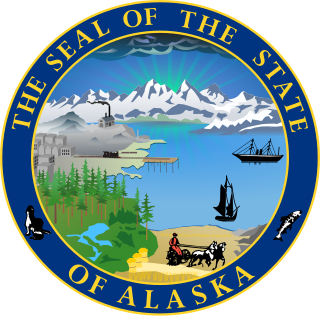
The Alaska State Legislature is the state legislature of the U.S. state of Alaska. It is a bicameral institution consisting of the 40-member Alaska House of Representatives and the 20-member Alaska Senate. There are 40 House Districts (1–40) and 20 Senate Districts (A–T). With a total of 60 lawmakers, the Alaska State Legislature is the smallest bicameral state legislature in the United States and the second-smallest of all state legislatures. There are no term limits for either chamber. The Alaska State Legislature meets in the Alaska State Capitol in Juneau. The current meeting since 2023 is the 33rd Alaska State Legislature. The previous meeting, the 32nd Alaska State Legislature, met from 2021 to 2023.

The New Mexico Legislature is the legislative branch of the state government of New Mexico. It is a bicameral body made up of the New Mexico House of Representatives and the New Mexico Senate.

The Hawaii State Legislature is the bicameral state legislature of the U.S. state of Hawaii, consisting of the Hawaii State Senate and the Hawaii State House of Representatives. Each lawmaker represents single member district across the state. The powers of the legislature are granted under Article III of the Constitution of Hawaii. The legislature convenes at the Hawaii State Capitol building in the state capital of Honolulu, on the island of Oahu.
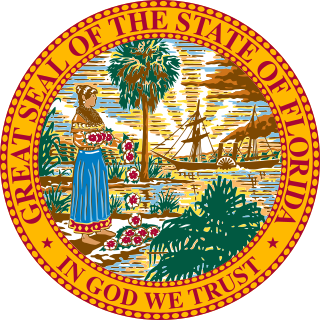
The Florida Legislature is the legislature of the U.S. state of Florida. It is organized as a bicameral body composed of an upper chamber, the Senate, and a lower chamber, the House of Representatives. Article III, Section 1 of the Florida Constitution, adopted in 1968, defines the role of the legislature and how it is to be constituted. The legislature is composed of 160 state legislators. The primary purpose of the legislature is to enact new laws and amend or repeal existing laws. It meets in the Florida State Capitol building in Tallahassee.

The Indiana General Assembly is the state legislature, or legislative branch, of the U.S. state of Indiana. It is a bicameral legislature that consists of a lower house, the Indiana House of Representatives, and an upper house, the Indiana Senate. The General Assembly meets annually at the Indiana Statehouse in Indianapolis.

The Colorado State Senate is the upper house of the Colorado General Assembly, the state legislature of the US state of Colorado. It is composed of 35 members elected from single-member districts, with each district having a population of about 123,000 as of the 2000 census. Senators are elected to four-year terms, and are limited to two consecutive terms in office. Senators who are term-limited become eligible to run again after a one-term respite.
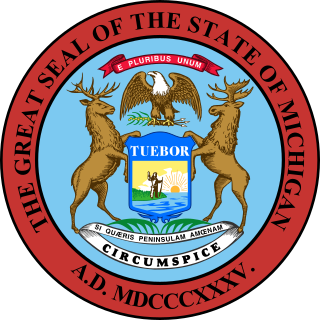
The Michigan Senate is the upper house of the Michigan Legislature. Along with the Michigan House of Representatives, it composes the state legislature, which has powers, roles and duties defined by Article IV of the Michigan Constitution, adopted in 1963. The primary purpose of the Legislature is to enact new laws and amend or repeal existing laws.

The Mississippi State Senate is the upper house of the Mississippi Legislature, the state legislature of the U.S. state of Mississippi. The Senate, along with the lower Mississippi House of Representatives, convenes at the Mississippi State Capitol in Jackson. The Lieutenant Governor of Mississippi serves as President of the Senate.

The Alaska State House of Representatives is the lower house in the Alaska State Legislature, the state legislature of the U.S. state of Alaska. The House is composed of 40 members, each of whom represents a district of approximately 17,756 people per 2010 census figures. Members serve two-year terms without term limits. With 40 representatives, the Alaska House is the smallest state legislative lower chamber in the United States. The House convenes at the State Capitol in Juneau.

The Arizona State Legislature is the state legislature of the U.S. state of Arizona. It is a bicameral legislature that consists of a lower house, the House of Representatives, and an upper house, the Senate. Composed of 90 legislators, the state legislature meets in the Capitol Complex in the state capital of Phoenix. Created by the Arizona Constitution upon statehood in 1912, the Arizona State Legislature met biennially until 1950. Since then they meet annually.

The Florida Senate is the upper house of the Florida Legislature, the state legislature of the U.S. state of Florida, the Florida House of Representatives being the lower house. Article III, Section 1 of the Constitution of Florida, adopted in 1968, defines the role of the Legislature and how it is to be constituted. The Senate is composed of 40 members, each elected from a single-member district with a population of approximately 540,000 residents. The Senate Chamber is located in the State Capitol building.

The West Virginia House of Delegates is the lower house of the West Virginia Legislature in West Virginia. Only three states—Maryland, Virginia, and West Virginia—refer to their lower house as the House of Delegates.

The Alabama State House of Representatives is the lower house of the Alabama Legislature, the state legislature of state of Alabama. The House is composed of 105 members representing an equal number of districts, with each constituency containing at least 42,380 citizens. There are no term limits in the House. The House is also one of the five lower houses of state legislatures in the United States that is elected every four years. Other lower houses, including the United States House of Representatives, are elected for a two-year term.

The Nevada Legislature is a bicameral body, consisting of the lower house, the Assembly, with 42 members, and the upper house, the Senate, with 21. With a total of 63 seats, the Legislature is the third-smallest bicameral state legislature in the United States, after Alaska's and Delaware's (62). The Nevada State Legislature as of 2019 is the first majority female State Legislature in the history of the United States. As of 2022, the Democratic Party controls both houses of the Nevada State Legislature. In the 2022 Nevada elections, which were a part of the midterm elections for that year, the Democratic Party obtained a supermajority in the lower house of the state legislature. As for the upper house of the state legislature, the elections provided the Democratic Party with thirteen of the twenty-one seats—amounting to a partisan composition of 61.9 percent.

The Louisiana State Legislature is the state legislature of the U.S. state of Louisiana. It is a bicameral body, comprising the lower house, the Louisiana House of Representatives with 105 representatives, and the upper house, the Louisiana State Senate with 39 senators. Members of each house are elected from single-member districts of roughly equal populations.

The Oklahoma Senate is the upper house of the two houses of the Legislature of Oklahoma, the other being the Oklahoma House of Representatives. The total number of senators is set at 48 by the Oklahoma Constitution.

The Kansas House of Representatives is the lower house of the legislature of the U.S. state of Kansas. Composed of 125 state representatives from districts with roughly equal populations of at least 19,000, its members are responsible for crafting and voting on legislation, helping to create a state budget, and legislative oversight over state agencies. Representatives are elected to two-year terms. The Kansas House of Representatives does not have term limits. The legislative session convenes at the Kansas State Capitol in Topeka annually.

The Kansas Senate is the upper house of the Kansas Legislature, the state legislature of the U.S. State of Kansas. It is composed of 40 senators elected from single-member districts, each with a population of about 73,000 inhabitants. Members of the Senate are elected to a four-year term. There is no limit to the number of terms that a senator may serve. The Kansas Senate meets at the Kansas State Capitol in Topeka.

The 2020 United States redistricting cycle is in progress following the completion of the 2020 United States census. In all fifty states, various bodies are re-drawing state legislative districts. States that are apportioned more than one seat in the United States House of Representatives are also drawing new districts for that legislative body.

